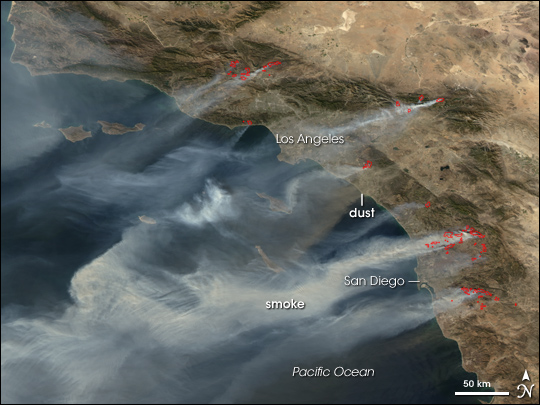Hurricane force winds slammed the coast! On December 2, fierce winds toppled trees, ripped up power lines and smashed through cities. A new tropical storm? No. Welcome to sunny California and the Santa Ana winds.
In the East Coast, the Atlantic Hurricane season just ended. People could breathe a sigh of relief. On the West Coast, however, the windy season is just reaching its peak. These winds are hot, dry, blasts from the mountains, not the flooding storms of the tropics.
Click to expand image below.

Santa Ana Winds. Credit: National Weather Service
In early December, a clockwise high-pressure system parked over Northern California and the Great Basin as a counter-clockwise low-pressure system hovered over Arizona. Like two massive gears spinning in opposite directions, the systems funneled the winds straight towards Southern California. The desert dried the air and any remaining moisture fell out as the winds blew through the mountains. Then it blasted downhill.
When air drops in altitude, it becomes more dens and this compression heats up the air. The air warms 29˚F for every mile that it drops. By time the winds squeeze through the canyons, they are hot and blasting.
Raymond Chandler famously described them as “those hot dry Santa Anas that come down through the mountain passes and curl your hair and make your nerves jump and your skin itch.” Urban legends claim these “Diablo Winds” cause more fights and murders. The blasts dry out vegetation and whip wild fires out of control.

Santa Ana winds can whip wildfires out of control, as they did during the 2007 La Niña. SOURCE: NASA
This month the winds were stronger and more widespread than usual. In Southern California, there were gusts of 80 mph, so strong that in Pasadena, firefighters responded to calls of downed trees every 12 seconds, according to the Weather Channel. Near Sacramento, the state capital, gusts topped 100 mph. At Mammoth Mountain's summit, the winds topped 150 mph, equivalent to a Category 3 hurricane.
This type of wind is not confined to California. December’s blustery weather extended across the Southwest, including Utah, Nevada, Wyoming, Arizona and New Mexico. In some places, including Utah, wind gusts topped 100 mph. In Canada, the winds are called Chinooks, and a late November Chinook peeled off part of the roof of an Alberta high school. “… like ripping a sheet off the bed.”
Experts say these Santa Anas were the worst in a decade and warn that the season is far from over. Whether you call them Santa Anas, Diablo winds, or Chinooks, the windy season will be blowing until spring.
